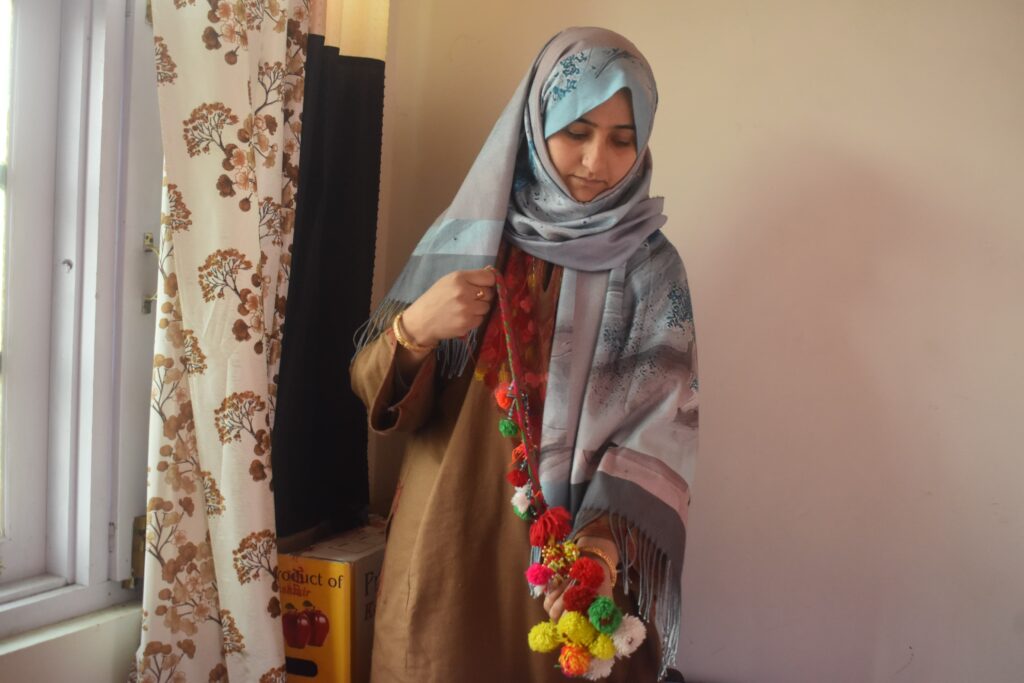
By Suhail Khan
Bandipora: In today’s digital era, where old traditions are slowly fading with the advent of modern technologies, people who actively work towards preserving and revitalising ancient practices are rare to find.
One such young woman in north Kashmir’s Bandipora district, Shahida Khanam, has taken it upon herself to preserve and revive the old traditions. She is making significant efforts to preserve traditional artifacts and has even set up a museum to showcase the rich heritage of the Gujjar community.
The Gujjar are an ethnic group found in the Indian state of Jammu and Kashmir, as well as in Pakistan, Afghanistan, and other parts of South Asia. They are primarily known for their pastoral and nomadic lifestyle and are considered to be one of the largest communities in the region.
For centuries, the Gujjar have called this land their home, imprinting their distinctiveness onto the local identity. The culturally diverse Jammu and Kashmir hosts various ethnic communities such as Kashmiris, Gujjars, Bakerwals, Paharis, and Dogras, each possessing their unique attires and traditions.
Traditionally, Gujjar women have been masters of needlework, excelling in the art of stitching, jewellery making, and embroidery. Their passion for preserving their traditional attire has successfully passed down through generations. However, in recent times, a concerning trend has emerged as the younger Gujjar generation shows less interest in embracing these rich traditions. Consequently, the fading art of making skull caps has dealt a severe blow to the livelihoods of many tribe members.

Upskilling women
Shahida Khanam, a 28-year-old tribal woman from Aragam village in Bandipora district told Siasat.com that after completing her Bachelors degree, she was unable to continue her education due to various reasons. “However, I made a decision to work for my tribal community and be their voice, aiming to bring positive change and security to their lives. In many tribal communities, women are often not allowed to work, so it was important for me to challenge these stereotypes and raise awareness about gender equality. In December 2022, I established a center where I started training girls fee of cost from the tribal community,” she said.
With the support of her family, girls from different parts of Bandipora in the tribal community began to come forward. In the first batch, Shahida trained 50 girls and women free of cost.
Shahida said that the purpose of her journey so far had been to help her community and raise awareness about the rich heritage of the Gujjar community. “As traditional attire of the tribal community is vanishing, it was crucial to revive and preserve these cultural practices. Therefore, in addition to provide training in stitching, jewellery making, and embroidery, I also worked towards collecting and displaying old tribal cultural artifacts in a museum,” she said.
Shahida said that after successfully completing training at her centre, the young girls were now skilled to earn while working from their homes. Shahida also mentioned that around 15 new girls were now coming to learn at the center. She stated that the center remains open from 10 am to 4 pm, with at least one-hour training in each of the skills.
“Our far-flung tribal areas lack a stable source of income, and poverty is widespread. The girls from our community are facing numerous hardships and truly need help during these challenging time, despite living in the digital age,” Shahida said.
Dilshada Bano, a trainee at her center, said, “At this center, we acquire diverse skills that not only create employment prospects for underprivileged young women like us but also help in safeguarding our cultural heritage. We genuinely cherish the learning experience here.”
The museum
Shahida said, “Since my childhood, I have noticed the difference in our tribal clothing compared to the normal Kashmiri attire. Recognising the difficulty in finding traditional cultural items, I aimed to preserve our old traditions for future generations. Unfortunately, there have been no efforts within the tribal community to save our old culture, despite its beauty and significance.”

In the museum, I have displayed full dresses, jewellery, traditional food items, carpets, chairs, ornaments, coins, dresses, earthen utensils and various other artifacts. However, my work is not complete yet, as I continue to collect more items from our tribal community with the help of local people.
“I am grateful for and indebted to my family, who have been a constant source of support and hope throughout my journey. Their support has been essential, particularly considering the challenges faced by tribal women in pursuing their dreams and working outside their communities, she said.
When asked what challenges did she face while doing her work, she said, “In a male-dominated society, it is always difficult for women. I also faced those difficulties. However, the criticism and negative comments fueled my determination to work even harder for my community, disregarding societal barriers.”
Preserving the past
With each step taken toward preserving Kashmir’s heritage, a ripple of hope spreads through the valleys. People have begun to realise that the preservation of their past doesn’t hinder progress but rather enhances it. It is the preservation of culture that adds depth and character to a society, a reminder of where it came from and a compass for where it can go.
Director of Handicrafts & Handloom department, Mahmood Ahmad Shah, expressed his appreciation for the youth who are actively making efforts to preserve the cultural heritage. He highlighted that the government is making efforts to support them through various schemes.
The handicraft department, according to him, has introduced four to five schemes which include financial assistance to cooperative societies, provision of centers, education for artisans, and ten percent incentives for exports. These schemes are already being implemented, but in order to ensure further growth, collaboration with banks is necessary.



